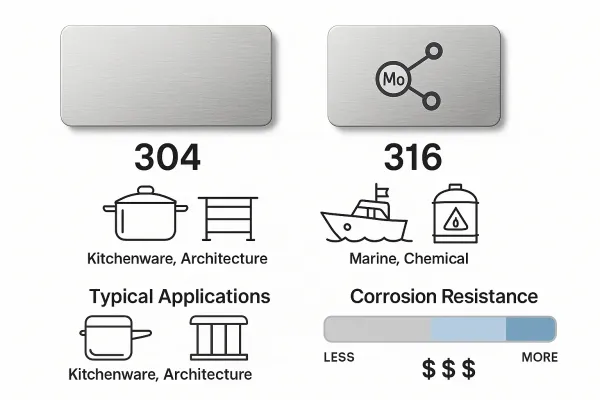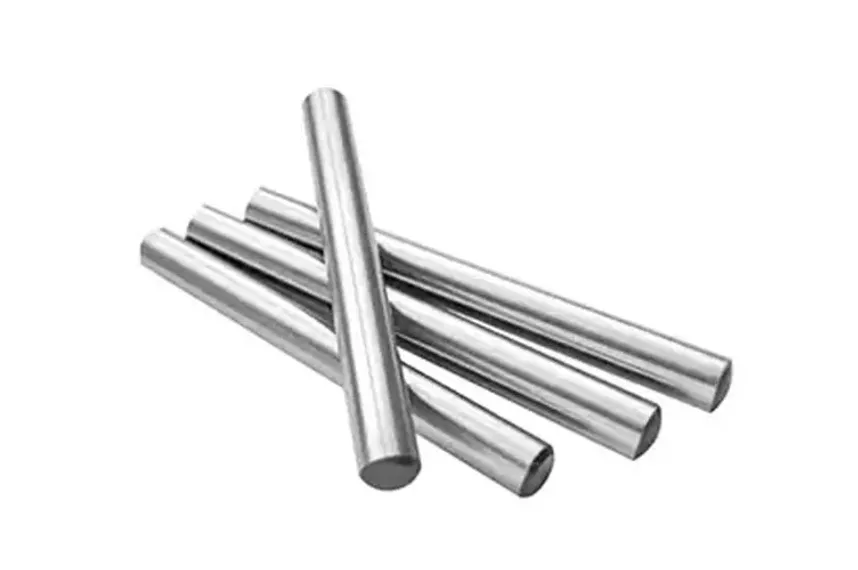Many buyers feel confused about choosing between 304 and 316 stainless steel. Making the wrong choice can lead to higher costs or poor durability.
304 and 316 stainless steel are two of the most common grades. 316 has added molybdenum, which increases corrosion resistance. 304 is more affordable and widely used.

Sometimes, picking the right grade is not just about the price. Your project’s environment and technical needs play a big part. I’ve spent years helping customers find the best solution for their needs. Let’s look at each key question in detail.
Many buyers wonder why 316 stainless steel costs more. The answer often comes down to raw materials and performance.
316 stainless steel contains molybdenum, which is expensive and makes it more resistant to corrosion than 304. This is the main reason for the higher price.
304 stainless steel has a basic composition of iron, chromium, and nickel. 316 stainless steel also contains about 2–3% molybdenum. This element is not cheap. The extra cost shows up in the final product price. Molybdenum boosts corrosion resistance, especially against chlorides and saltwater. For this reason, 316 is popular in marine and chemical settings. When I talk to customers who build near the sea or handle chemicals, I always recommend 316, even though it costs more. The price is not just for the raw material. It also reflects the added performance and longer service life in harsh conditions.
| Property | 304 Stainless Steel | 316 Stainless Steel |
|---|---|---|
| Nickel (%) | 8–10.5 | 10–14 |
| Chromium (%) | 18–20 | 16–18 |
| Molybdenum (%) | 0 | 2–3 |
| Price | Lower | Higher |
| Corrosion Resist | Good | Excellent |
If you only need basic corrosion resistance for indoor use, 304 is enough. If your products face saltwater or harsh chemicals, the higher price of 316 is worth it.
| Feature | 304 | 316 |
|---|---|---|
| Molybdenum Content | 0% | 2–3% |
| Corrosion Resistance | Good | Excellent |
| Price Level | $ | $$$ |
| Typical Use | General | Marine/Chemical |
It’s easy to mix up 304 and 316 stainless steel just by looking. Many buyers want to know how to tell the difference.
You can identify 304 and 316 stainless steel through material testing. 316 usually shows higher corrosion resistance and contains molybdenum, which is not found in 304.
In my factory, we often use a mix of chemical and physical tests to identify grades. The fastest way is a chemical spot test. We use a test solution that reacts with molybdenum. If the steel is 316, the solution changes color. For more accuracy, a portable X-ray fluorescence (XRF) analyzer can scan the metal and show the full composition. This device can instantly tell if molybdenum is present, confirming 316. Buyers sometimes ask for a Mill Test Certificate (MTC) with each shipment. This document lists the exact chemical makeup. Here is what to look for:
Sometimes, I meet customers who want to tell by sight alone. Visually, both grades look the same. The difference only shows in tough environments after time passes. For big projects, always ask your supplier for chemical analysis reports to make sure you get the right material.
| Identification Method | 304 Stainless Steel | 316 Stainless Steel |
|---|---|---|
| Spot Test Solution | No color change | Color change |
| XRF Analysis | No Mo detected | Mo detected |
| MTC Document | No Mo | 2–3% Mo |
| Saltwater Exposure | Some rust over time | Resistant |
Customers want to buy the “best” stainless steel for their project. But “best” can mean different things in different situations.
The best stainless steel depends on your project’s needs. 304 is best for general use. 316 is best for harsh or corrosive environments.

Choosing the best stainless steel always starts with the application. If you need corrosion resistance and affordability for kitchenware, indoor railings, or structural parts, 304 works well. It is easy to weld, form, and polish. For outdoor uses, especially near the sea or chemicals, 316 is safer. The added molybdenum helps 316 resist pitting and rust in harsh conditions. In the oil and gas sector, some customers even need duplex or super duplex grades, which perform better under high pressure and extreme environments. These are more expensive, but sometimes only 316 or higher grades will work.
Here’s a quick comparison:
| Application | Best Stainless Steel | Why |
|---|---|---|
| Indoor railing | 304 | Cost-effective, easy to polish |
| Marine handrail | 316 | Superior corrosion resistance |
| Food processing | 304 or 316 | Both are safe, 316 for more acidic conditions |
| Chemical plant | 316 or higher | Resists harsh chemicals |
Always talk to your supplier about your project. This way, you can avoid overpaying for features you do not need.
Some buyers choose the highest grade, thinking it is always better. But higher grades mean higher costs. I often help customers balance performance with budget, so they only pay for what brings value.
Many projects can use either 304 or 316, but knowing when to pick each one is key to good results.
Use 304 stainless steel for indoor and general use. Use 316 stainless steel for marine, chemical, or outdoor applications with high corrosion risks.

304 is the most widely used stainless steel. It covers most architectural, kitchen, and furniture projects. When I work with customers building indoor railings or furniture, I recommend 304. It offers a good mix of price and corrosion resistance for these settings. If your project faces high humidity, saltwater, or chemicals, 316 is a safer bet. For example, I worked on a hotel by the ocean. The salty air made 304 railings rust after a year. Switching to 316 solved the problem. In the chemical industry, 316 is often the default choice because of its added resistance. Hospitals, food factories, and swimming pools also prefer 316 in some areas.
| Scenario | Recommended Grade |
|---|---|
| Indoor railings | 304 |
| Outdoor urban area | 304 or 316 |
| Coastal construction | 316 |
| Swimming pools | 316 |
| Food production | 304 or 316 |
| Chemical storage | 316 |
Always consider the working environment first. If in doubt, ask your supplier for advice. Using 316 only where it matters can save costs.
When project budgets are tight, finding the cheapest option matters. Many buyers want to know the lowest-cost stainless steel.
The cheapest stainless steel is usually grade 201, which has less nickel and more manganese than 304 or 316.

Grade 201 replaces some of the nickel in 304 with manganese and nitrogen. Nickel is expensive. Reducing nickel content lowers costs. This makes 201 much more affordable than 304 or 316. Many furniture makers and interior designers pick 201 for projects that do not need strong corrosion resistance. I have seen buyers choose 201 for indoor handrails, shelves, and decorations. The price advantage is clear, but there are trade-offs. 201 is less resistant to rust and is not suitable for outdoor or marine use. It can develop stains and rust spots faster than 304 or 316. When customers only care about appearance and budget, 201 is the first option I mention. For long-term durability, I recommend 304 as the minimum grade.
| Stainless Steel Grade | Nickel (%) | Main Alloy | Price | Rust Resistance |
|---|---|---|---|---|
| 201 | 3.5–5.5 | Manganese/Nitro | Lowest | Fair |
| 304 | 8–10.5 | Nickel | Medium | Good |
| 316 | 10–14 | Nickel/Mo | High | Excellent |
Many customers believe stainless steel never rusts. This is not always true, especially for 304 grade.
304 stainless steel can rust in harsh conditions, such as marine or heavily polluted environments. Proper care reduces the risk of rust.
304 stainless steel is rust-resistant, but not rust-proof. In most indoor settings, it keeps its finish for many years. However, when exposed to saltwater, industrial pollution, or acids, it may develop rust spots or stains over time. I have seen customers install 304 railings near the sea, only to find surface rust within a year. The problem is worse in places with high chloride levels, such as swimming pools or coastal buildings. Cleaning and maintenance help, but only to a point. When I discuss projects with clients in these areas, I recommend upgrading to 316 stainless steel. For ordinary indoor or dry environments, 304 is more than enough and will stay bright and clean with basic care.
| Environment | Rust Risk (304) | Solution |
|---|---|---|
| Indoors, dry | Low | 304 is sufficient |
| Urban, outdoors | Medium | Clean and inspect often |
| Coastal, marine | High | Use 316 or coat surface |
| Chemical exposure | High | Use 316 or higher |
Choosing between 304 and 316 stainless steel depends on your budget, environment, and project needs. Make sure you match the grade to your application.
Are Glass Balustrades a Good Idea? The Ultimate Modern Glass Railing System for Balconies and Staircases
Stainless Steel Tube Manufacturers: Seamless, Alloy & Stainless Steel Tubing Explained
Welded Stainless Steel Tubing & Tube: 304 Stainless, 321, OD/Wall Thickness and Pipe Specs
Stainless Steel Handrail Design:Stainless Steel Handrail & Railing Ideas for Your Stair